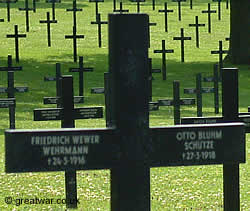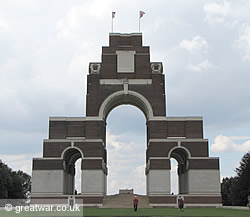Lochnagar Mine Crater Memorial, La Boisselle, Somme Battlefields
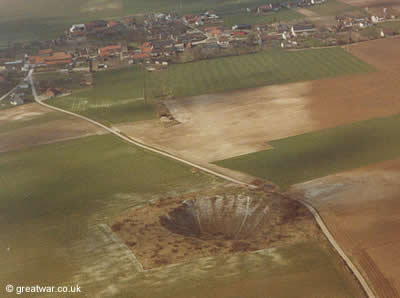
|
The Lochnagar mine crater on the 1916 Somme battlefields in France is the largest man-made mine crater created in the First World War on the Western Front. It was laid by the British Army's 179th Tunnelling Company Royal Engineers underneath a German strongpoint called “Schwaben Höhe”. The mine was exploded two minutes before 07.30 am Zero Hour at the launch of the British offensive against the German lines on the morning of 1st July 1916.
The British division attacking in this sector was 34th Division of III Corps. All twelve battalions in this division, each with a fighting strength of about 700 men, went into the attack that morning. Despite the successful blowing of the mine and the damage caused to the German strongpoint, the German defenders managed to get into well-placed positions to fire at the advancing British soldiers. Within half an hour of the start of the infantry attack many hundreds of them were already dead or wounded.
- The Lochnagar Mine Crater as a Memorial
- The Cross
- Private George Nugent, Tyneside Scottish
- In Remembrance
- Annual Service of Remembrance
- The Lochnagar Crater Foundation
- Donations
- Location of Lochnagar Crater
The Lochnagar Mine Crater as a Memorial
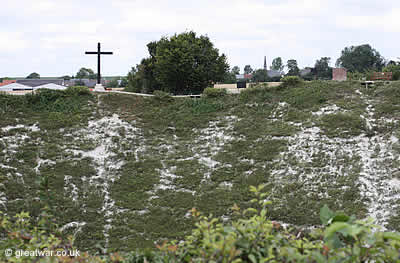
|
On 1st July 1978 the piece of ground containing this huge crater was purchased by Richard Dunning. At that time the crater was a place of interest visited by just a few people during the year: historians of the First World War, pilgrims visiting a relative's grave and a very small number of organised battlefield tours. The crater was not formally maintained and on occasion it was found to have rubbish dumped at the bottom and was also being used by cross-country type motorbikes.
The historical significance of the site and the fact that this ground still contains the undiscovered remains of German, French and British soldiers from the Great War of 1914-1918 convinced Richard that it was a place which should be preserved. Richard's aim is to preserve the site and to make it a Garden of Remembrance and a place where visitors to the Somme can find a quiet opportunity for reflection. As a memorial it commemorates the men and women of all nations whose lives were affected by the Great War of 1914-1918.
The number of visitors to this site has increased dramatically in recent times, reaching approximately 200,000 people now visiting each year. Many of the visitors are young British and French students and schoolchildren, spending time on the battlefields as part of their studies of First World War history.
The Lochnagar Crater Memorial is privately owned. No profit has ever, or will ever, be made from the site of Lochnagar Crater. The upkeep of the site is totally dependant on private funding and donations.
The Cross
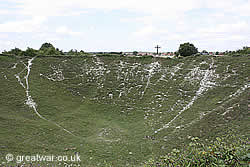
|
The wooden cross was placed at the crater in 1986. The wooden beams it was made from were beams removed from the roof of a deconsecrated church near Durham in England. Soon after the cross was erected at the crater it was struck by lightning, and metal bands were placed around the wood where it had been slightly damaged.
The origins of the wooden beams from a former church in Durham are significant as many of the British soldiers killed here on 1st July during the attack on the German Front Line were men from Tyneside in the north-east of England. Many of them miners, they were recruited to form several battalions in the regiment of the Northumberland Fusiliers. The Tyneside battalions which attacked at Lochnagar Crater fought with 34th Division as:
- the 102nd Tyneside Scottish Brigade (20th, 21st, 22nd and 23rd Battalions Northumberland Fusiliers) and
- the 103rd Tyneside Irish Brigade (24th, 25th, 26th and 27th Battalions Northumberland Fusiliers).
Private George Nugent, Tyneside Scottish
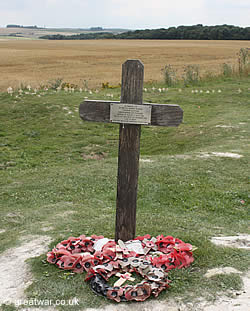
|
Many hundreds of British soldiers were killed in the vicinity of Lochnagar Crater on the morning of 1st July. Four battalions of the Tyneside Scottish (21st, 22nd, 23rd and 24th Northumberland Fusiliers), some 2,400 men, advanced to the crater after it was exploded, passed around the crater and made for the German positions to its rear.
One of these British soldiers from the Tyneside Scottish battalions was missing in action on the day and commemorated on the Thiepval Memorial to the Missing at its unveiling in 1932. However, his remains were found in ground at the south side of the crater on 31st October 1998.
Identification of the remains was possible and he was identified as Private George James Nugent, No. 22/1306, serving with 22nd Battalion Northumberland Fusiliers (Tyneside Scottish) on 1st July 1916. He was the son of William and Emma Nugent and husband of Nora Nugent. He lived at 34 Frankling Street, Shieldfield, Newcastle-upon-Tyne. He was 28 years old when he was killed. George's remains were reburied at the nearby Ovillers Military Cemetery in grave reference Plot I, Row A, grave 26A. A wooden cross marks the place on the south side of the Lochnagar Crater where he was found.
In Remembrance
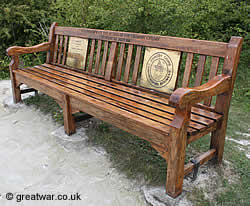
|
A number of wooden benches have been placed at the site in memory of those men who were in action attacking with the 34th Division at La Boisselle village and Lochnagar Crater area on 1st July 1916.
The crater itself is a place of Remembrance. A veteran of 1st July recalled seeing bodies rolled into the crater after the battle had passed this place within the next few days of July. Some of those remains may have been recovered at a later date, but without doubt there are remains of Germans and British casualties missing in action at this place who still lie in and around the crater.
Annual Service of Remembrance
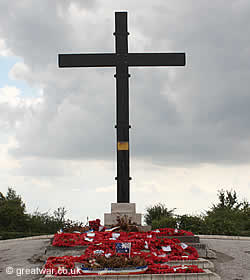
|
On 1st July a Service of Remembrance is held at 07.28 hours at the Lochnagar Crater, at the exact time when the mine was exploded on that day in 1916. The service is in memory of the men who went into the attack in this place and all along the British attacking front in the early hours of 1st July 1916, the launch of the Battle of the Somme 1916. The ceremony also serves to remember the men and women of all nations who experienced the First World War.
The Remembrance Service lasts for about one hour. Wreaths are laid at the foot of the cross and poppy petals are usually laid at the base of the crater. In recent years many hundreds of pilgrims travelling to the battlefields for the commemoration of the Battle of the Somme have attended the early morning Lochnagar Crater Service of Remembrance.
Visitors are always welcome to attend the ceremony, but are advised that the area may be especially busy on special anniversary years so it is recommended to arrive in good time and if possible to park in the village of La Boisselle and walk to the crater.
The Lochnagar Crater Foundation
The Lochnagar Crater Foundation was founded by volunteers who have given their time and money over many years towards the upkeep of this historic site. To find out more about the site visit the website:
Website: www.lochnagarcrater.org
Donations
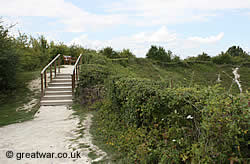
|
The Lochnagar Crater regularly needs maintenance and donations are always welcome to the Lochnagar Foundation. It is not only necessary to protect and preserve the crater from natural erosion from the weather but the large number of visitors, increasing year by year, also adds to the requirement for the continued provision of safe and sensitively constructed visitor access to this memorial site. The site is privately owned and does not receive funding from any government organisation.
To make a donation you can do so via the Lochnagar Foundation website:
Website: lochnagarcrater.org Donate
Access to the Crater
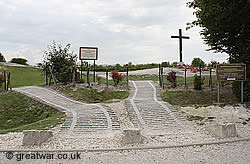
|
The entrance to the site was recently structured with the creation of a formal point of access. This was done with the aid of a small grant from the French.
The Friends of Lochnagar have laid formal pathways from the entrance to the crater at the roadway to the lip of the crater and for a short distance either side of the wooden Remembrance Cross. This should offer all visitors the opportunity to visit the crater on an even surface at least as far as the lip of it.
Beyond the formal path visitors can make their way around the complete circumference of the crater on a pathway. At certain points there are a few wooden steps with handrails.
Visitors are advised to take great care on the path and children should be supervised at all times. In wet weather the chalk path can be slippery.
Danger
The grounds of the crater beyond the chalk path on the lip of the crater may be dangerous and warning signs are clearly visible. Visitors are strongly advised to respect the private property laws and not to pick up any battlefield ordnance that might be seen on or near the site.
Location of Lochnagar Crater
Lochnagar Crater is located on the southern part of the 1916 Somme battlefields to the south of the D929 Albert-Bapaume road and immediately south of the village of La Boisselle. From the D929 enter the village of La Boisselle in the direction of Contalmaison. Take a right turn which will be signposted to the crater with a sign for “La Grande Mine”.
Latitude N 50° 1' 57" ; Longitude E 2° 41' 50"
Access and Parking for Vehicles
The road to the crater is narrow and provides a single point of entry and exit to the crater. It is a single track road, with tarmac as far as the crater.
It is suitable for coaches, however the possibility to turn a large vehicle around at the crater may be difficult. There is a hardstanding area opposite the crater entrance, but this is no longer available for visitors to use as it is regularly in use by the local farmers.
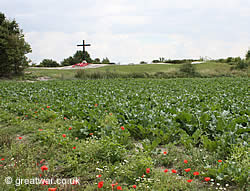
|
There is parking space for a limited number of cars at the crater entrance, and one disignated car space with a weight limit of four tonnes due to possible subsidence. coach drivers are requested to respect the limit in this particular parking space.
At busy times of year, particularly on or around 1st July, and if there are lots of vehicles it may be easier to park in the village (with respect for the local residents) and walk to the crater.
Related Topics
Visiting the Somme Battlefields of WW1
Cemeteries on the Somme Battlefields
There are many military cemeteries on the Somme battlefields ranging in size from those with just a few graves to large concentration cemeteries.
Cemeteries on the Somme Battlefields
British Monuments and Memorials on the Somme Battlefields
The names of the men missing in action during the Battle of the Somme 1916 are named on the Thiepval Memorial to the Missing. There are also numerous memorials located on the battlefield of 1916 dedicated to the divisions who fought there:
Monuments on the Somme Battlefields
Further Reading

La Boiselle: Somme (Battleground Europe) [Paperback]
By Michael Stedman
This book in the Battleground Europe guidebook series contains maps, itineraries, historical background and photographs about the village in the Battle of the Somme during July 1916. Published by Pen & Sword Books Ltd (1 Oct 1996). 196 pages. ISBN-10: 0850525403, ISBN-13: 978-0850525403

Tyneside Scottish: 20th, 21st, 22nd and 23rd (Service) Battalions of the Northumberland Fusiliers (Pals) [Paperback]
By Graham Stewart and John Sheen
This book is one of the Pals Battalions series. Published by Pen & Sword Books Ltd (12 Jan 1998). 256 pages. ISBN-10: 0850526310, ISBN-13: 978-0850526318

Tyneside Irish [Hardcover]
By John Sheen
This book is one of the Pals Battalions series. Published by Pen & Sword Military (21 Jan 2010). 500 pages. ISBN-10: 1848840934, ISBN-13: 978-1848840935

Somme 1st July 1916 [DVD]
By Michael Stedman
Studio: Pen & Sword Books Ltd (7 Feb 2011). ASIN: 1844159922
Acknowledgements
The Lochnagar Crater Foundation.
Personal details for Private George Nugent: Debt of Honour Register held by the Commonwealth War Graves Commission. For details about the CWGC see our page at:

